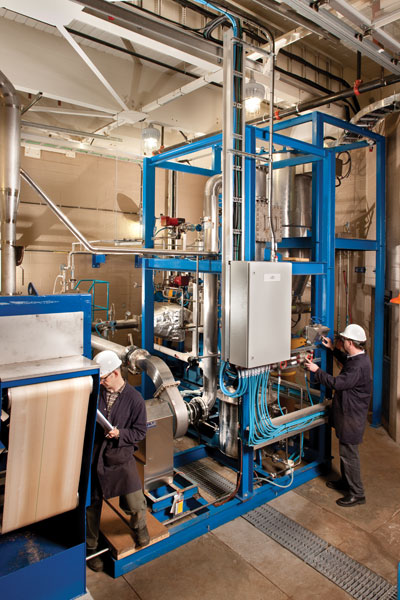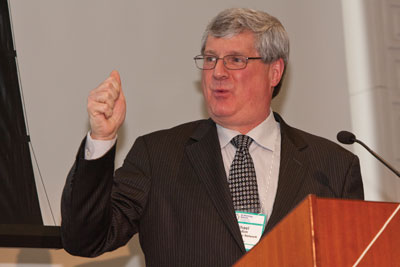
BC Bioenergy Invests in Biomass Future
June 4, 2012
By
David Manly
British Columbia is well known for its natural resources, especially its beautiful forests that seem to stretch endlessly into the distance.
British Columbia is well known for its natural resources, especially its beautiful forests that seem to stretch endlessly into the distance. Therefore, it is no surprise that bioenergy and biomass have found a perfect home here.

|
|
In mid-February, Canadian Biomass visited BC Bioenergy Network (BCBN), a not-for-profit society that specializes in funding bioenergy technologies and capacity-enhancing programs for industries, private companies and communities throughout British Columbia.
“Our mandate is focused on networking to build a world-class bioenergy industry in British Columbia,” says Michael Weedon, executive director of the network. “And developing such an industry is really quite a huge challenge – you need assertive companies, creative communities, and you need visionary policy, leadership and support.”
BCBN achieves this by investing in and supporting companies and innovations through a $25-million grant provided in 2008 by the B.C. Ministries of Environment, and Energy, Mines and Petroleum Resources. In the four years since it was founded, BCBN has allocated roughly half of its funding through investments, loans and contributions for capacity-building projects.
Since BCBN only funds a partnership portion of the total cost for each project, the accrued value of all investments is $78 million from spending a total of $13.2 million, or just slightly over half of its budget. By leveraging its investments with other partners at a ratio of 6:1, BCBN is able to invest in much larger projects than it would normally be able to do on its own.
According to Weedon, the goal of these investments under the mandate is to advance technology and thereby generate jobs, trigger economic and social development, produce real environmental benefits, and create a sustainable energy export business, with BCBN acting as a catalyst to help foster and grow these opportunities.
GREEN TECHNOLOGY
The projects that BCBN supports fall under three main categories: forestry, municipal and agricultural, with the bulk of initial funding split between municipal and forestry initiatives. However, each project has applications that can influence or improve the others.
 |
|
| “We try to provide value in some form to every potential project, even if we do not provide direct funding,” says Scott Stanners, director of research at BC Bioenergy Network. | |
 |
|
| Michael Weedon, executive director of BC Bioenergy Network, says members look for technology that can fill a knowledge gap.
|
The network currently has 23 projects in various stages of development, with the distribution split into 11 large technological development/demonstration projects and 12 capacity-building projects (such as providing staff and equipment).
One of BCBN’s largest investments is with Nexterra Systems Corp. for $3 million. It comprises two parts.
The first focuses upon research and development to demonstrate and produce ultra-clean synthetic gases that can be used as low-emission gases for heating or use in a reciprocating engine to produce electricity at Nexterra’s Kamloops research and development centre. The second is to support a commercial demonstration for the installation of a gasifier and reciprocating engine at the University of British Columbia to produce both hot water and electricity.
With these types of projects, the biggest obstacle is not the technology, but people’s misconceptions about the emissions from woody biomass renewable fuels, says Scott Stanners, director of research at BC Bioenergy Network.
“Most of the general public are not aware that biomass can be combusted or gasified and result in emissions of particulate matter that are cleaner than natural gas. Many people believe that burning wood residues will generate dangerous emissions that can be toxic,” says Stanners.
“In fact, with the development of new technology and appropriate emissions abatement systems, emissions from woody biomass have reduced 1,000-fold over the past 40 years and can demonstrate energy efficiency upwards of 90% with technology available today.”
Another area of research that BCBN is excited about is in partnership with Lignol Innovations Ltd., representing another $3 million investment.
The project aims to covert lignocellulosic biomass into fuel ethanol at a demonstration plant, according to Weedon. The plant will also be able to produce specialty chemicals such as high-purity lignin that could be used to replace carbon fibre.
“The future of energy is going to be based upon local use of resources, local transformation and local consumption,” he said. “It will be increasingly difficult to afford to ship energy all over the world as fuels become more expensive.”
With a growing concern about the current global energy supply, BCBN selects projects to invest in that have both present benefits and future potential.
KNOWLEDGE GAP
When a project is submitted to BCBN for approval, the researchers or companies create an expression of interest to describe the research or project, how it fits the mandate, and how it can be further developed.
From there, the ideas are explored, researched and examined for suitability, innovation and feasibility by the board of directors before a decision is made on an economic, environmental and social basis. One of the best criteria to judge by, according to Weedon, is if the research is truly novel and will broaden the use of the energy source through using low-cost feedstock or reducing the cost of energy production.
“We look at technology that fills a gap or is very appealing,” says Stanners. “Then, if it has a good chance of being implemented as claimed, we go through a contracting stage where we either make a contribution agreement with milestones or go through a loan process. Then we follow up and track the results and share a company’s success with others.”
But, direct funding is not the only way BCBN can help.
While most expressions of interest seek funding, the network has other ways to help, such as networking, bringing in other funding agencies and making future recommendations about the project.
“We try to provide value in some form to every potential project,” says Stanners, “even if we do not provide direct funding.”
Future Foundation
Recently, BC Bioenergy Network was invited to present to the British Columbia Bio-Economy Legislative Committee on 10 bioenergy opportunities that show great potential across the province. The presentation highlighted a variety of technological and industrial innovations that have the potential to advance the bioeconomy.
In the presentation, the first two opportunities discussed utilizing organic waste streams to displace fossil fuels and torrefacted wood to displace coal. These processes have the greatest potential for growth in British Columbia because they allow for the continued use of existing infrastructure, which can reduce overall project costs.
“You want to use existing infrastructure or plants,” said Weedon, “and the oil and gas industries have long been experts at this – taking fossil fuels and using every component – the same principles need to apply to energy from biomass.”
Other options discussed included district heating systems, supporting off-grid remote communities, biochemical production, improved biomass drying and finding uses for underutilized/damaged wood.
Ideally, BCBN would like to fund every one of these projects, but with a limited budget, members have to select those that meet their mandate and seem the most likely to succeed within a near term time frame.
But, that is not their ultimate goal.
The network’s role is to kick-start a bioenergy industry, both within British Columbia and across the rest of Canada that has the potential to create affordable, safe and renewable energy. And the best way to accomplish that, added Weedon, is through fostering growth, development and innovation.
“Our ultimate legacy will be the investments, growing them and having others replicate them.”
Print this page